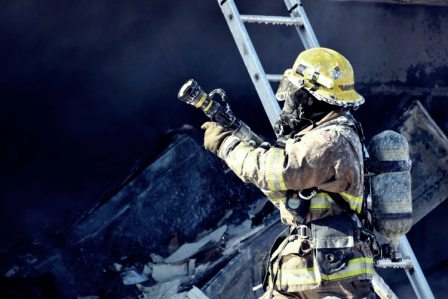Firefighting Foam and Cancer – Recovering Compensation

Firefighting is a noble career, and it’s no surprise that many children grow up wanting to become members of a firefighting precinct so they can save lives. In addition, other career options that open up include working in the military as a firefighter as well as a standby firefighter at the many airports across the country. Firefighters are highly trained to handle all types of fires, and thanks to scientific developments that occurred in the 1950’s, today’s firefighters don’t have to worry about a fire overpowering them as we’ll see later on in this post.
Firefighting foam is a technological marvel that was first introduced in the late 1950’s when scientists successfully created an artificial plastic-like compound that was able to cover the surface of a fire with a film that could stop the spread of said fire as well as cut off the oxygen supply in order to stop flames in their tracks. This compound, known as aqueous film firefighting foam is made of carbon-like products that are petroleum based known as perfluoroalkyl and polyfluoroalkyl substances. These substances have very strong carbon bonds that make them so effective at completely cutting off any oxygen and other vapors from reaching the fire. However, they also have toxic health effects that were known about for the longest time, but kept from the public in the interest of making a profit at the expense of the lives of individuals.
Aqueous firefighting foam was first created by 3M, a chemical production company in the late 1950’s. it was then adopted by the military, fire departments, refineries and airports around the world given its efficacy which was, frankly speaking, too good to be true. Interestingly, a decade later after its release, blood samples taken from workers exposed to AFFF showed the presence of PFAS, or perfluoroalkyl and polyfluoroalkyl substances. In addition, the military, comprising of the Navy and the U.S. Air Force started to realize that the compound was toxic to the environment. Shockingly, these entities continued to use the chemical as the complete picture wasn’t available until many decades later.
Does AFFF Cause Cancer?
What’s disturbing about AFFFs that have PFA chemicals is their ability to persist in the environment indefinitely. This is because of the strong carbon bonds present in the molecules of the chemical, which effectively makes AFFFs “forever chemicals”. Over time, forever chemicals, due to their propensity to linger in the body for decades, cause inflammation and cellular changes, setting the stage for the development of cancers that are usually so advanced by the time an oncologist diagnoses them.
Individuals that work in the following areas are likely to suffer firefighting foam cancer:
- Firefighters in different precincts countrywide
- Individuals working in the military
- Those living near military bases
- Those working at the airport
- Individuals living near firefighting precincts
- Oil and chemical refinery workers
Here are some of the other health complications associated with PFOS and PFOAs
- Higher triglycerides
- Thyroid hormone abnormalities
- Increase in liver enzymes
- Lower antibodies
- Ulcerative colitis
- Rheumatoid arthritis
- Asthma
- Pregnancy difficulties and miscarriage
The cancers most commonly associated with firefighting foam include:
- Kidney tumors
- Ovarian tumors
- Liver tumors
- Leydig cell tumors
- Prostate cancer
- Pancreatic cancer
- Testicular cancer
- Skin melanoma
- Bladder cancer
- Hodgkin’s lymphoma
It is important to note that cancers associated with firefighting foam usually are insidious. This means that they slowly develop over time, are not diagnosed for many years, and may even be attributed to as a chance occurrence. However, if you were exposed to firefighting foam at any given time, your cancer is most likely caused by the compounds found in this chemical, and not as a result of lifestyle or genetic factors.
Manufacturers that could potentially be held liable for your firefighting foam cancer are:
- 3M Company
- Angus Fire
- Buckeye Fire Protection Co.
- The Ansul Co.
- Chemguard
- Kiddie Fire Fighting Inc.
- United Technologies Corp
AFFF Toxic Chemical Lawsuits – What Do You Have to Prove?
As a consumer, you put your faith and trust in manufacturers when purchasing their products, safe in the knowledge that they have done their due diligence to make sure that they manufacture products that are safe. This is legally known as standard of care which you are entitled to from all manufacturers you buy products from. Should they breach this standard of care causing you harm, you are legally empowered to recover money damages by way of a product liability lawsuit which usually takes on the form of a class action lawsuit or mass tort claim.
In order to prove liability for firefighting foam lawsuits, the following must be present:
- The manufacturer owed you a duty of care
- The manufacturer breached this duty of care
- The breach caused your injury or injuries
- The risks should have been foreseen by the manufacturer
- You suffered damages
By filing a firefighting foam lawsuit with us, you’ll be able to recover money damages which are economic and non-economic for things like medical bills, lost wages, legal bills, expenses that are out of pocket, emotional distress, permanent disfigurement or disability, loss of consortium or companionship, loss of future earning capacity and so much more.
AFFF Foam Class Action Lawsuit – Call Us Today!
McCready Law is a leading class action lawsuit law firm that deals with numerous drug torts. We have helped tens of thousands of individuals seek justice over the years, and we have combined experience and expertise that spans over 90 years. In addition, we have recovered over $30 million in just 20 years, and no case is too small, or too big for us. If you’d like to file a firefighting foam cancer lawsuit and have the claim receive personalized attention, we’re the law firm to do it with. Please reach out to us at (773) 673-9861, or fill the contact form on the site in order to get started. All cases are handled on a contingency fee basis which means that you don’t pay anything out of pocket until we recover compensation on your behalf for your firefighting foam lawsuit. Thanks, and we look forward to hearing from you.

